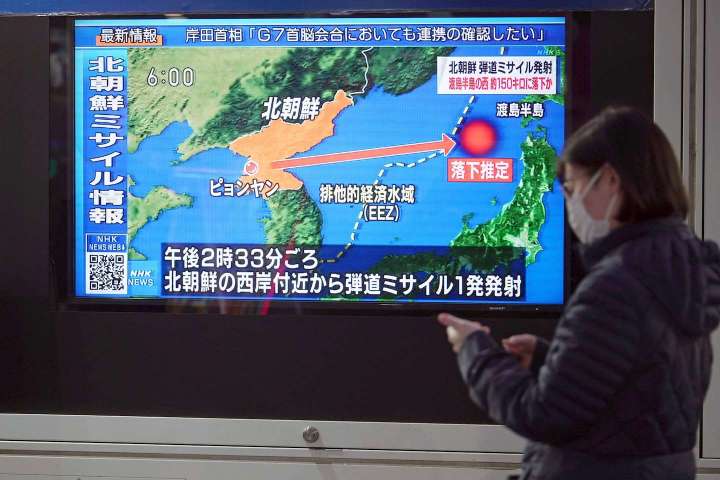TOKYO — North Korea launched a suspected intermediate-range ballistic missile over Japan, Japanese and South Korean officials said Tuesday. The missile, which was the first North Korean projectile to pass through Japanese airspace since 2017, landed in the Pacific Ocean.
North Korea fires ballistic missile over Japan, prompting evacuation order

North Korea has tested an unprecedented number of missiles this year as it diversifies and expands its weapons arsenal, part of leader Kim Jong Un’s five-year plan. North Korea has conducted five rounds of ballistic missile tests since Sept. 24, ahead of Vice President Harris’s visit to the region last week.
In recent weeks, the U.S., Japanese and South Korean governments have all conducted military exercises designed to demonstrate the allies’ readiness to work together in the event of a conflict. The latest launch came as the United States and South Korea wrap up their joint military exercises involving the USS Ronald Reagan, a nuclear-powered aircraft carrier.
On Tuesday, the U.S. and South Korean militaries conducted a precision bombing training against targets in the sea drills in response to the North Korean missile.
While the allied countries say the drills are defensive in nature, Kim’s regime has long viewed them as hostile acts and used them to justify its weapons development and nuclear program. Tuesday’s launch is the seventh time since 1998 that North Korea has launched a missile over Japan.
There are signs that a new cycle of escalation is taking shape, with North Korea rejecting overtures and possibly preparing for a seventh nuclear test amid a diplomatic deadlock with Washington and shifting security dynamics in the region.
North Korea’s Foreign Ministry announced Tuesday that it supports Russia’s proclaimed annexation of parts of Ukraine, as Pyongyang and Moscow draw closer in the aftermath of the invasion. Meanwhile, the diplomatic feud between Japan and Russia is deepening, as Tokyo expelled a Russian consul Monday in retaliation for the detention and expulsion of a Japanese consul in Vladivostok. Japan was among the countries that imposed wide-reaching economic sanctions on Russia this year.
On Tuesday morning, residents in the Aomori prefecture woke up to the noise of blaring sirens warning them of the missile launch. Fishermen who work off the coast of Aomori in the waters where the missile fell told Japanese news outlets that the launch was a serious threat to their safety.
Japanese Prime Minister Fumio Kishida convened a meeting of the National Security Council in response and condemned the launch. Japanese officials said they sent the strongest words of condemnation possible through diplomatic channels.
“The recent repeated launch of missiles is outrageous, and we strongly condemn this,” Kishida said.
President Biden spoke by phone with Kishida on Tuesday. Biden condemned the missile launch, according to a White House readout of the call, and reaffirmed U.S. commitments to Japan and South Korea.
The intermediate-range ballistic missile may be similar to, or could be, the Hwasong-12, according to missile experts. The missile’s reach includes Japan and Guam, a U.S. territory in the Pacific Ocean to the east of Japan.
North Korea launched the missile from Chagang province in the northern part of the country, South Korean military officials said. The missile was launched at 7:22 a.m., and it flew 4,600 kilometers (2,858 miles) for 22 minutes over Aomori prefecture before landing in the Pacific, Japanese officials said. Its maximum height was 1,000 kilometers (621 miles).
From the North Korean perspective, there are not many flight-path options for a missile with a range of above 4,000 kilometers other than the route over Hokkaido and toward the Pacific Ocean, said Masashi Murano, a Japan chair fellow at the Hudson Institute in Washington. The other options would be seen as an effort to strike the U.S. mainland or to reach Guam.
While it is not yet clear whether North Korea fired a new missile or one it previously tested, Murano said, Pyongyang may perceive this moment as an opportune time to test its weapons capabilities.
“The fact that the U.S. has hardly reacted to the daily launch of short-range missiles may have some bearing on this,” Murano said. “In addition, the Biden administration has been focused on ongoing issues — dealing with the Russian invasion of Ukraine may also have played a role. As a result, [Kim] may have thought it could now conduct the test without strong U.S. punishment.”
The United States will “take all necessary measures, involving all elements of American national power” to defend South Korea and Japan, Daniel Kritenbrink, the U.S. assistant secretary of state for East Asian and Pacific affairs, said at an online event held shortly after the launch, according to Reuters.
Kritenbrink said the United States would leave the door open to dialogue but “respond resolutely” to North Korea’s growing threat.
Min Joo Kim in Seoul, Julia Mio Inuma in Tokyo and Amy B Wang in Washington contributed to this report.






